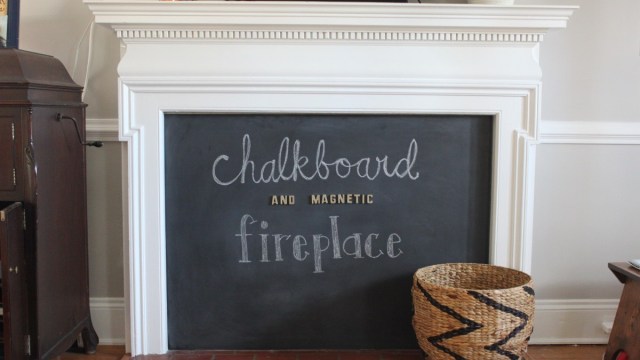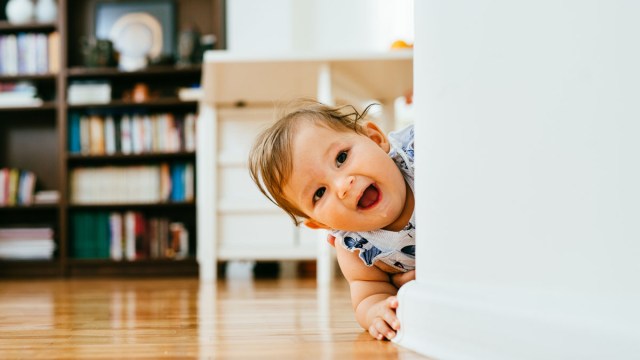Although it seems like it was just yesterday you were bringing your sweet baby home for the first time, the months have flown by. You’ve joyfully witnessed baby’s first smile, first time rolling over (both ways), and don’t even get us started on how amazing it was the first time baby sat—without padding or leaning on anything. Sounds like crawling is just around the corner—yet another in the line of baby’s firsts. That means it’s time to start babyproofing the place.
Our handy babyproofing checklist includes clever DIY tricks that make your home safer for your child and can save you some money too. Whether you need to babyproof your cabinets, your fireplace, or drawers, these ideas are a great place for any parent to start.
When to Start Babyproofing
As your little one gets close to crawling, it’s time to babyproof your house and other places they visit frequently, like grandparents’ homes. To start, get on the floor and look at the surroundings from a baby’s perspective. See what’s tempting to grab and pull on, what’s at eye level, and what could injure them. Then, put away fragile items, move cords, secure furniture that could fall over, and put padding on sharp edges. Every few months, and when your child reaches a new milestone, like walking, evaluate your home for additional babyproofing needs. As kids grow taller, the danger zones will change and likely increase.
Babyproofing Checklist for Your House
1. Secure stairway railings
The railings on staircases or landings on upper floors may look narrow, but they’re big enough for kids’ limbs (or heads) to get stuck in. Secure clear plastic or fabric to railings to deter kids from playing on them.
2. Hide cleaning products
Plastic bins with lids and latches that baby can’t open are a safer place for cleaning products than under your kitchen sink. If you can store them on a high shelf or out of sight in a tall cabinet, that’s even better.
3. Corral cords
Cut a slit down an empty paper towel roll or piece of pipe insulation and thread multiple wires through it to keep them from becoming tangled in your tot’s curious hands. You can also use zip ties to pull together cords and then tuck them far away from baby’s reach. Don’t forget your USB cords that still hold a charge when they’re plugged in.
4. Cover outlets
Plastic covers are the easiest way to cover outlets around the house (and safest too). But in a pinch, or when you’re visiting relatives or traveling, you can put adhesive bandages, duct tape, or painter’s tape over electrical outlets. Avoid cartoon varieties of bandages that will attract little ones’ attention.

5. Block off the fireplace
Babyproof a fireplace without sacrificing aesthetics too much by covering the opening with a piece of magnetic chalkboard (we love the one above from Sassy Wife/Classy Life). The chalkboard blocks off the fireplace and give little ones a surface on which to draw with chalk and play with magnets (choose large magnets that don’t pose a choking hazard).
6. Place dishtowels out of reach
Nix the dishtowel hanging off your oven door handle. Kids can pull down on it and open a hot oven or bonk themselves with the heavy door. Move towels to a higher shelf or put them on command hooks out of baby’s reach.
7. Test choking hazards with a toilet paper tube
There’s no need to purchase a choke tester. Anything that can fit into an empty toilet paper tube is small enough for your baby to choke on. Keep all those wee things out of reach.
Related: 8 Summer Safety Tips for Baby Parents
8. Create a TP protector
Babies love to unroll toilet paper as much as pets do. Keep your TP intact and out of baby’s hands and mouth with a two-liter soda bottle! Cut off the top and bottom of the bottle and cut a slit down the remaining center piece. Use tape to cover sharp, raw edges and slide the container over your toilet roll to cover it. See the tutorial at My Frugal Baby Tips.
9. Protect with pool noodles
These summertime staples can be used for everything from door stoppers to crib-rail covers that prevent tots from rolling out of bed. They’re also good for wrapping around sharp edges, like around the fireplace, to minimize bumps and scrapes.
10. Pad corners with tennis balls
Tennis balls can soften sharp corners where a pool noodle doesn’t fit. Cut a few small slices into the ball’s core so you can wedge it over items like table corners. It may not look pretty, but this hack is pretty temporary. Before you know it, your toddler will be steady enough on their feet that you no longer feel the need to protect every corner of your home.
11. Shorten pull cords
Use clothespins or twist ties to shorten and hold up pull cords on curtains and blinds to remove this strangulation risk from your home. Command hooks are also handy for keeping cords out of reach.
12. Sock it to knobs
To keep little hands from turning door knobs, cover them with a spare sock and wrap a hair tie or rubber band around the base to hold the sock in place. An adult can still squeeze and turn the handle, but a child won’t be able to.
13. Band together on horizontal cabinets
Attach hair ties or rubber bands to keep paired cabinet doors closed. Just loop the tie around the handles and your baby will only be able to open the doors a little bit, not wide enough to slip a hand through.
14. Get a handle on vertical drawers
Slide a yardstick or tension rod (or another long, thin object) through the handles of horizontally stacked drawers, rather than spending time and money on individual locks.
Make sure to capture photos of your baby crawling around their newly babyproofed pad—and share them with your family and friends near and far—with the Tinybeans app. The secure platform puts parents in total control of who sees and interacts with photos and videos of their kids.











